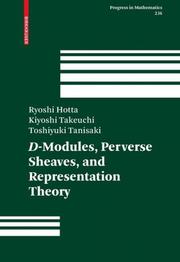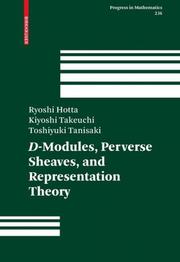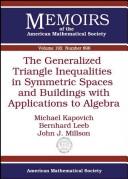| Listing 1 - 7 of 7 |
Sort by
|
Book
ISBN: 9780821846759 0821846752 Year: 2008 Volume: 43 Publisher: Providence (R.I.): American mathematical society,
Abstract | Keywords | Export | Availability | Bookmark
 Loading...
Loading...Choose an application
- Reference Manager
- EndNote
- RefWorks (Direct export to RefWorks)
Arithmetic groups --- Linear algebraic groups --- 512.54 --- Algebraic groups, Linear --- Geometry, Algebraic --- Group theory --- Algebraic varieties --- 512.54 Groups. Group theory --- Groups. Group theory
Book
ISBN: 9780821844694 Year: 2008 Publisher: Providence, R.I. American Mathematical Society
Abstract | Keywords | Export | Availability | Bookmark
 Loading...
Loading...Choose an application
- Reference Manager
- EndNote
- RefWorks (Direct export to RefWorks)
Algebra --- Topological groups. Lie groups --- 51 <082.1> --- Mathematics--Series --- Lie groups. --- Linear algebraic groups. --- Representations of groups. --- Lie, Groupes de. --- Groupes algébriques linéaires. --- Représentations de groupes. --- Lie groups --- Linear algebraic groups --- Representations of groups --- Group representation (Mathematics) --- Groups, Representation theory of --- Group theory --- Algebraic groups, Linear --- Geometry, Algebraic --- Algebraic varieties --- Groups, Lie --- Lie algebras --- Symmetric spaces --- Topological groups
Book
ISBN: 9780387788357 0387788344 9780387788340 0387788352 9786611954338 1281954330 Year: 2008 Volume: 251 Publisher: New York (N.Y.): Springer,
Abstract | Keywords | Export | Availability | Bookmark
 Loading...
Loading...Choose an application
- Reference Manager
- EndNote
- RefWorks (Direct export to RefWorks)
This book treats Jacques Tits's beautiful theory of buildings, making that theory accessible to readers with minimal background. It includes all the material of the earlier book Buildings by the second-named author, published by Springer-Verlag in 1989, which gave an introduction to buildings from the classical (simplicial) point of view. This new book also includes two other approaches to buildings, which nicely complement the simplicial approach: On the one hand, buildings may be viewed as abstract sets of chambers with a Weyl-group-valued distance function; this point of view has become increasingly important in the theory and applications of buildings. On the other hand, buildings may be viewed as metric spaces. Beginners can still use parts of the new book as a friendly introduction to buildings, but the book also contains valuable material for the active researcher. There are several paths through the book, so that readers may choose to concentrate on one particular approach. The pace is gentle in the elementary parts of the book, and the style is friendly throughout. All concepts are well motivated. There are thorough treatments of advanced topics such as the Moufang property, with arguments that are much more detailed than those that have previously appeared in the literature. This book is suitable as a textbook, with many exercises, and it may also be used for self-study.
Buildings (Group theory) --- Immeubles (Théorie des groupes) --- Buildings (Group theory). --- Algebra --- Mathematics --- Physical Sciences & Mathematics --- Linear algebraic groups. --- Immeubles (Théorie des groupes) --- EPUB-LIV-FT LIVMATHE LIVSTATI SPRINGER-B --- Theory of buildings (Group theory) --- Tits's theory of buildings (Group theory) --- Algebraic groups, Linear --- Mathematics. --- Algebraic geometry. --- Group theory. --- Topological groups. --- Lie groups. --- Group Theory and Generalizations. --- Algebraic Geometry. --- Topological Groups, Lie Groups. --- Geometry, Algebraic --- Group theory --- Algebraic varieties --- Linear algebraic groups --- Geometry, algebraic. --- Topological Groups. --- Groups, Topological --- Continuous groups --- Algebraic geometry --- Geometry --- Groups, Theory of --- Substitutions (Mathematics) --- Groups, Lie --- Lie algebras --- Symmetric spaces --- Topological groups --- Geometry, Algebraic.

ISBN: 9783540785835 3540785833 3540785841 Year: 2008 Publisher: Berlin : Springer,
Abstract | Keywords | Export | Availability | Bookmark
 Loading...
Loading...Choose an application
- Reference Manager
- EndNote
- RefWorks (Direct export to RefWorks)
Algebraic groups are treated in this volume from a group theoretical point of view and the obtained results are compared with the analogous issues in the theory of Lie groups. The main body of the text is devoted to a classification of algebraic groups and Lie groups having only few subgroups or few factor groups of different type. In particular, the diversity of the nature of algebraic groups over fields of positive characteristic and over fields of characteristic zero is emphasized. This is revealed by the plethora of three-dimensional unipotent algebraic groups over a perfect field of positive characteristic, as well as, by many concrete examples which cover an area systematically. In the final section, algebraic groups and Lie groups having many closed normal subgroups are determined.
Linear algebraic groups. --- Lie groups. --- Group theory. --- Groupes linéaires algébriques --- Groupes de Lie --- Groupes, Théorie des --- Linear algebraic groups --- Lie groups --- Group theory --- Geometry --- Algebra --- Mathematical Theory --- Mathematics --- Physical Sciences & Mathematics --- Théorie des groupes --- Groups, Theory of --- Substitutions (Mathematics) --- Groups, Lie --- Algebraic groups, Linear --- Mathematics. --- Algebraic geometry. --- Nonassociative rings. --- Rings (Algebra). --- Topological groups. --- Group Theory and Generalizations. --- Algebraic Geometry. --- Topological Groups, Lie Groups. --- Non-associative Rings and Algebras. --- Lie algebras --- Symmetric spaces --- Topological groups --- Groups, Topological --- Continuous groups --- Algebraic rings --- Ring theory --- Algebraic fields --- Rings (Algebra) --- Algebraic geometry --- Math --- Science --- Geometry, Algebraic --- Algebraic varieties --- Geometry, algebraic. --- Topological Groups. --- Algebra. --- Mathematical analysis

ISBN: 9780817645236 9780817643638 Year: 2008 Publisher: Boston Basel Berlin : Birkhäuser,
Abstract | Keywords | Export | Availability | Bookmark
 Loading...
Loading...Choose an application
- Reference Manager
- EndNote
- RefWorks (Direct export to RefWorks)
D-modules continues to be an active area of stimulating research in such mathematical areas as algebra, analysis, differential equations, and representation theory. Key to D-modules, Perverse Sheaves, and Representation Theory is the authors' essential algebraic-analytic approach to the theory, which connects D-modules to representation theory and other areas of mathematics. Significant concepts and topics that have emerged over the last few decades are presented, including a treatment of the theory of holonomic D-modules, perverse sheaves, the all-important Riemann-Hilbert correspondence, Hodge modules, and the solution to the Kazhdan-Lusztig conjecture using D-module theory. To further aid the reader, and to make the work as self-contained as possible, appendices are provided as background for the theory of derived categories and algebraic varieties. The book is intended to serve graduate students in a classroom setting and as self-study for researchers in algebraic geometry, and representation theory.
Ordered algebraic structures --- Geometry --- algebra --- topologie (wiskunde) --- Topological groups. Lie groups --- Algebra --- landmeetkunde --- wiskunde --- Group theory --- Représentations d'algèbres de Lie --- Representations of Lie algebras --- Linear algebraic groups. --- D-modules. --- Representations of groups. --- Groupes algébriques linéaires --- D-modules, Théorie des --- Représentations de groupes --- Groupes algébriques linéaires --- D-modules, Théorie des --- Représentations de groupes

ISBN: 0817645233 081764363X Year: 2008 Publisher: Boston, MA : Birkhäuser Boston : Imprint: Birkhäuser,
Abstract | Keywords | Export | Availability | Bookmark
 Loading...
Loading...Choose an application
- Reference Manager
- EndNote
- RefWorks (Direct export to RefWorks)
D-modules continues to be an active area of stimulating research in such mathematical areas as algebra, analysis, differential equations, and representation theory. Key to D-modules, Perverse Sheaves, and Representation Theory is the authors' essential algebraic-analytic approach to the theory, which connects D-modules to representation theory and other areas of mathematics. Significant concepts and topics that have emerged over the last few decades are presented, including a treatment of the theory of holonomic D-modules, perverse sheaves, the all-important Riemann-Hilbert correspondence, Hodge modules, and the solution to the Kazhdan-Lusztig conjecture using D-module theory. To further aid the reader, and to make the work as self-contained as possible, appendices are provided as background for the theory of derived categories and algebraic varieties. The book is intended to serve graduate students in a classroom setting and as self-study for researchers in algebraic geometry, and representation theory.
Linear algebraic groups. --- D-modules. --- Representations of groups. --- Group representation (Mathematics) --- Groups, Representation theory of --- Group theory --- Modules (Algebra) --- Algebraic groups, Linear --- Geometry, Algebraic --- Algebraic varieties --- Algebra. --- Group theory. --- Topological Groups. --- Geometry, algebraic. --- Group Theory and Generalizations. --- Topological Groups, Lie Groups. --- Commutative Rings and Algebras. --- Algebraic Geometry. --- Algebraic geometry --- Geometry --- Groups, Topological --- Continuous groups --- Groups, Theory of --- Substitutions (Mathematics) --- Algebra --- Mathematics --- Mathematical analysis --- Topological groups. --- Lie groups. --- Commutative algebra. --- Commutative rings. --- Algebraic geometry. --- Rings (Algebra) --- Groups, Lie --- Lie algebras --- Symmetric spaces --- Topological groups --- Geometry, Algebraic.

ISBN: 9780821840542 Year: 2008 Publisher: Providence, R.I. American Mathematical Society
Abstract | Keywords | Export | Availability | Bookmark
 Loading...
Loading...Choose an application
- Reference Manager
- EndNote
- RefWorks (Direct export to RefWorks)
Algebra --- 51 <082.1> --- Mathematics--Series --- Semisimple Lie groups --- Linear algebraic groups --- Geometric group theory --- Lorentz groups --- Symmetric spaces --- Rings (Algebra) --- Groupes de Lie semi-simples --- Groupes algébriques linéaires --- Groupes, Théorie géométrique des --- Lorentz, Groupes de --- Espaces symétriques --- Anneaux (algèbre) --- Spaces, Symmetric --- Geometry, Differential --- Semi-simple Lie groups --- Lie groups --- Algebraic rings --- Ring theory --- Algebraic fields --- Algebraic groups, Linear --- Geometry, Algebraic --- Group theory --- Algebraic varieties --- Groups, Lorentz --- Continuous groups --- Groupes de Lie semi-simples. --- Groupes algébriques linéaires. --- Groupes, Théorie géométrique des. --- Lorentz, Groupes de. --- Espaces symétriques.
| Listing 1 - 7 of 7 |
Sort by
|

 Search
Search Feedback
Feedback About UniCat
About UniCat  Help
Help News
News